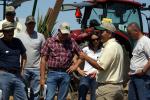NOVELTY, Mo. – With significant crop yield reductions across Missouri and much of the Midwest, lots of nutrients and herbicides remain in the soil, having never been absorbed by drought-stricken corn and soybean plants. This presents opportunities and challenges for farmers looking to plant cover, winter or forage crops this fall.
Kevin Bradley, associate professor in the Division of Plant Sciences in the University of Missouri College of Agriculture, Food and Natural Resources (CAFNR), offered guidance to producers at Greenley Research Center’s annual field day, Aug. 7.
First and foremost, check labels, Bradley said. Several factors will influence herbicide carryover, including the type of herbicide applied, rate applied, time it was applied, the soil pH and rainfall since the initial application.
In fields where uncertainty of carryover is high, Bradley recommends farmers conduct a soil bioassay before sowing their fields. Farmers should gather soil samples from across the field in question several weeks before they intend to plant their fall crops, mix the samples together and plant their seeds into pots to evaluate whether there’s any indication of herbicide carryover injury.
It’s important to have a control sample as well. Farmers should use soil from a plot where there is no concern with carryover for the control. This simple test can help farmers avoid the loss of wheat, forages or other crops they’ll plant in the coming weeks. Bradley provided a chart detailing the replant interval for winter wheat and forage grasses following dozens of herbicides used in Missouri. (See “Consider Herbicide Carryover Potential before Planting Wheat or Forage Grasses this Fall” at http://ipm.missouri.edu/IPCM/.)
For farmers like Winford Vaughn, that information is critical. Vaughn grows corn and soy near Edina, Mo., and often plants rye as a cover crop, or plants winter wheat.
Sowing new seeds
In addition to hearing about dealing with drought, Vaughn said he was intrigued by several of the ongoing studies at Greenley. “I found the tillage radishes very interesting too. I want to take care of my soil and the radish interested me a lot for that purpose,” Vaughn said. “I’m a firm believer in putting organic matter back in the soil, and I’ve seen the results.”
Leah Sandler, a graduate student in plant sciences, discussed the potential for using tillage radish as a cover and grazing crop. In 2012, it showed promise for weed suppression, soil aeration and as supplemental forage. Sandler shared preliminary results from the first year of the study.
On the tour wagon there was a lively dialogue on different row spacing for the tuber. Sandler will continue research trials for the next few years to answer these questions: How much forage can they produce? How well do they suppress weeds, primarily henbit and common chickweed? How is the corn crop affected the following year? Sandler said radishes are also purported to help drought tolerance in corn.
The current drought, considered by many to be one of the worst Missouri has endured, was discussed throughout the day. “It’s challenging times like these where we really appreciate our research centers and the Agricultural Experiment Station,” said Brian Munzlinger, a Missouri state senator and Greenley board member.
Field days are an opportunity for producers to ask research and extension faculty one-on-one questions and learn about the latest practices they can take home to their farms. Dennis Dawson attends most years and has a cow/calf operation just east of the research center. Before the tours even began, he discussed strategies for renovating his pastures with Rob Kallenbach, forage specialist and professor in the Division of Plant Sciences in CAFNR. Dawson also had several questions about sowing winter forages.
After the tours, Marc Linit, associate dean for research and extension in CAFNR, provided an update on what’s happening on campus and emphasized the importance of stakeholder input in shaping the future of agriculture in the state. “We’re all about partnerships and bringing insightful and timely information to you,” Linit said.
Linit reminded the more than 200 attendees that 2012 marks the 150th anniversary of the Morrill Act, which established the land-grant university system. “It’s arguably among the most significant pieces of legislation our country has ever passed,” Linit said.
“Higher education is the seed corn for economic development in this state,” he added.
CAFNR is changing the core components of society that impact what we eat, where we live and how we’ll face tomorrow. As the University of Missouri’s College of Agriculture, Food and Natural Resources, we are at the forefront of research and education, working toward global sustainability.
Read more http://extension.missouri.edu/news/DisplayStory.aspx?N=1490





